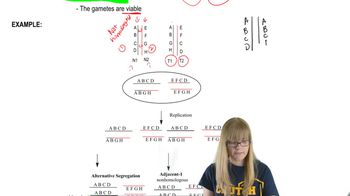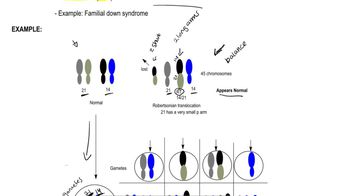Table of contents
- 1. Introduction to Genetics51m
- 2. Mendel's Laws of Inheritance3h 37m
- 3. Extensions to Mendelian Inheritance2h 41m
- 4. Genetic Mapping and Linkage2h 28m
- 5. Genetics of Bacteria and Viruses1h 21m
- 6. Chromosomal Variation1h 48m
- 7. DNA and Chromosome Structure56m
- 8. DNA Replication1h 10m
- 9. Mitosis and Meiosis1h 34m
- 10. Transcription1h 0m
- 11. Translation58m
- 12. Gene Regulation in Prokaryotes1h 19m
- 13. Gene Regulation in Eukaryotes44m
- 14. Genetic Control of Development44m
- 15. Genomes and Genomics1h 50m
- 16. Transposable Elements47m
- 17. Mutation, Repair, and Recombination1h 6m
- 18. Molecular Genetic Tools19m
- 19. Cancer Genetics29m
- 20. Quantitative Genetics1h 26m
- 21. Population Genetics50m
- 22. Evolutionary Genetics29m
6. Chromosomal Variation
Chromosomal Rearrangements: Translocations
Problem 24a
Textbook Question
A boy with Down syndrome (trisomy 21) has 46 chromosomes. His parents and his two older sisters have a normal phenotype, but each has 45 chromosomes.
What is the probability the next child of this couple will have a normal phenotype and have 46 chromosomes? Explain your answer.
 Verified step by step guidance
Verified step by step guidance1
Understand that Down syndrome is caused by an extra copy of chromosome 21, resulting in trisomy 21.
Recognize that the boy with Down syndrome has 46 chromosomes due to the presence of an extra chromosome 21, while his parents and sisters have 45 chromosomes, indicating a Robertsonian translocation.
A Robertsonian translocation involves the fusion of two acrocentric chromosomes, which can lead to a balanced carrier state with 45 chromosomes but a normal phenotype.
Consider the possible gametes produced by a parent with a Robertsonian translocation: normal, balanced translocation, and unbalanced gametes.
Calculate the probability of the next child inheriting a normal set of chromosomes (46) and a normal phenotype, considering the possible gametes and their combinations.
Recommended similar problem, with video answer:
 Verified Solution
Verified SolutionThis video solution was recommended by our tutors as helpful for the problem above
Video duration:
2mPlay a video:
Was this helpful?
Key Concepts
Here are the essential concepts you must grasp in order to answer the question correctly.
Chromosomal Abnormalities
Chromosomal abnormalities occur when there is a deviation from the normal number of chromosomes in a cell. In the case of Down syndrome, also known as trisomy 21, an individual has three copies of chromosome 21 instead of the usual two, leading to various phenotypic traits. Understanding how these abnormalities arise, such as through nondisjunction during meiosis, is crucial for analyzing genetic outcomes in offspring.
Recommended video:
Guided course

Chromosome Structure
Mendelian Genetics
Mendelian genetics refers to the principles of inheritance established by Gregor Mendel, which describe how traits are passed from parents to offspring through alleles. In this context, the normal phenotype and chromosomal count of the parents suggest that they may carry recessive alleles or chromosomal variations that do not express in their phenotype. This concept is essential for calculating the probability of the next child inheriting a normal phenotype.
Recommended video:
Guided course

Descriptive Genetics
Probability in Genetics
Probability in genetics involves calculating the likelihood of certain traits or genetic conditions occurring in offspring based on parental genotypes. In this scenario, understanding the genetic makeup of the parents and the potential combinations of alleles is necessary to determine the probability that their next child will have a normal phenotype and 46 chromosomes. This involves using tools like Punnett squares to visualize potential genetic outcomes.
Recommended video:
Guided course

Probability

 12:42m
12:42mWatch next
Master Reciprocal Translocation with a bite sized video explanation from Kylia Goodner
Start learningRelated Videos
Related Practice



